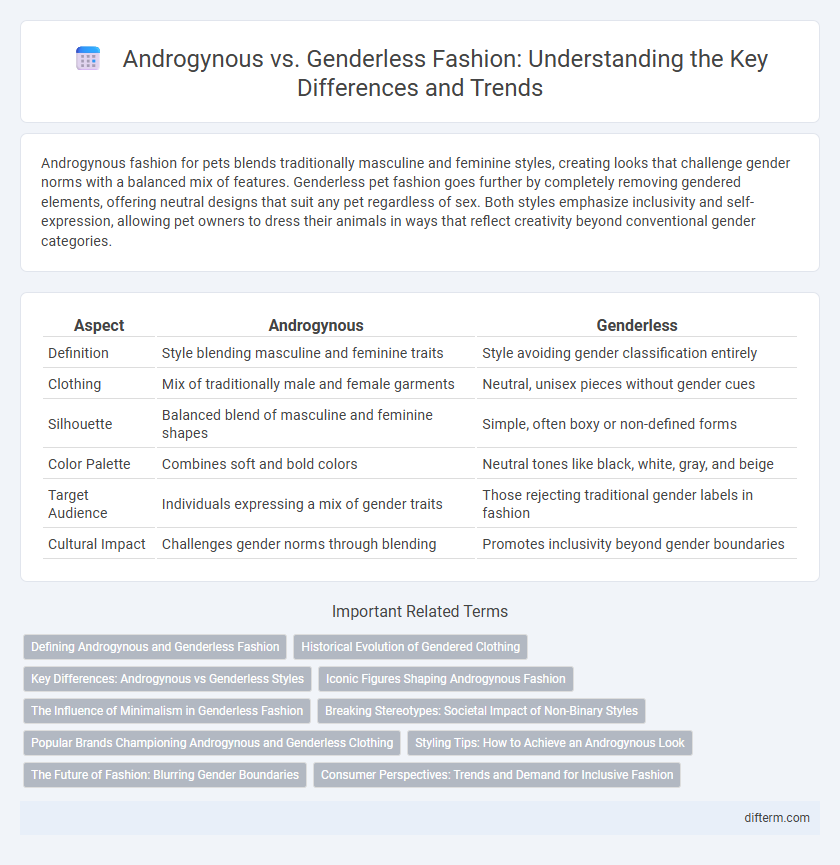Androgynous fashion for pets blends traditionally masculine and feminine styles, creating looks that challenge gender norms with a balanced mix of features. Genderless pet fashion goes further by completely removing gendered elements, offering neutral designs that suit any pet regardless of sex. Both styles emphasize inclusivity and self-expression, allowing pet owners to dress their animals in ways that reflect creativity beyond conventional gender categories.
Table of Comparison
| Aspect | Androgynous | Genderless |
|---|---|---|
| Definition | Style blending masculine and feminine traits | Style avoiding gender classification entirely |
| Clothing | Mix of traditionally male and female garments | Neutral, unisex pieces without gender cues |
| Silhouette | Balanced blend of masculine and feminine shapes | Simple, often boxy or non-defined forms |
| Color Palette | Combines soft and bold colors | Neutral tones like black, white, gray, and beige |
| Target Audience | Individuals expressing a mix of gender traits | Those rejecting traditional gender labels in fashion |
| Cultural Impact | Challenges gender norms through blending | Promotes inclusivity beyond gender boundaries |
Defining Androgynous and Genderless Fashion
Androgynous fashion blends traditionally masculine and feminine elements, creating a versatile style that challenges binary gender norms through tailored cuts, neutral colors, and unisex silhouettes. Genderless fashion transcends traditional gender categories entirely, emphasizing fluidity and inclusivity by promoting designs that avoid gender-specific conventions and celebrate individuality. Brands like Telfar and Rad Hourani lead the movement with collections that embrace these principles, reshaping the fashion industry's approach to identity and self-expression.
Historical Evolution of Gendered Clothing
Androgynous fashion emerged prominently during the early 20th century, challenging traditional gender norms by blending masculine and feminine styles, as seen in Coco Chanel's pioneering designs and the 1920s flapper look. Genderless clothing gained momentum in the late 2010s, driven by social movements advocating non-binary identities and inclusivity, reflecting a shift away from gender-specific garment conventions. Historical evolution shows a progression from rigid Victorian gendered attire to contemporary fashion embracing fluidity and the dismantling of binary dress codes.
Key Differences: Androgynous vs Genderless Styles
Androgynous fashion blends traditionally masculine and feminine elements, creating a balanced, hybrid look that challenges gender norms while retaining gender-specific cues. Genderless style removes all gender associations, emphasizing neutral silhouettes, tones, and designs that can be worn by anyone regardless of gender identity. Key differences lie in intention and presentation: androgynous fashion intentionally mixes gender signifiers, whereas genderless fashion aims to eliminate gender markers altogether.
Iconic Figures Shaping Androgynous Fashion
Iconic figures such as David Bowie, Tilda Swinton, and Janelle Monae have profoundly shaped androgynous fashion by challenging traditional gender norms and blending masculine and feminine aesthetics. Their distinctive styles emphasize fluidity, creating a dynamic dialogue between masculinity and femininity that transcends conventional clothing categories. Through innovative design and bold self-expression, these trailblazers have propelled androgynous fashion into mainstream culture, influencing designers and consumers worldwide.
The Influence of Minimalism in Genderless Fashion
Minimalism drives genderless fashion by stripping design to essential forms and neutral palettes, dissolving traditional gender boundaries. Emphasizing clean lines, functional silhouettes, and understated details, this approach fosters inclusivity and versatility in wardrobes. The minimalistic ethos honors self-expression beyond gender norms, aligning with evolving cultural attitudes toward identity fluidity.
Breaking Stereotypes: Societal Impact of Non-Binary Styles
Androgynous fashion blends traditionally male and female elements, challenging rigid gender norms and promoting fluidity in personal expression. Genderless styles reject specific gender associations altogether, fostering inclusivity and dismantling binary stereotypes in the fashion industry. Both approaches drive societal progress by encouraging acceptance and redefining identity beyond conventional gender frameworks.
Popular Brands Championing Androgynous and Genderless Clothing
Popular brands championing androgynous and genderless clothing include Telfar, who blend minimalism with unisex designs that challenge traditional gender norms, and Gucci, which incorporates fluid silhouettes and diverse models in their collections. Other key players like Rad Hourani and 69 showcase collections that emphasize inclusivity and reject binary fashion standards by offering versatile pieces suitable for all genders. These brands leverage innovative fabrics and cutting-edge tailoring to appeal to a broad audience seeking fashion that transcends conventional gender categories.
Styling Tips: How to Achieve an Androgynous Look
Achieving an androgynous look involves blending masculine and feminine elements, such as pairing tailored blazers with fitted jeans or incorporating unisex accessories like watches and minimalist jewelry. Neutral color palettes including blacks, whites, and grays emphasize the balance between gendered styles, allowing for versatile outfit combinations. Choosing structured silhouettes and avoiding overtly gender-specific clothing enhances the androgynous aesthetic, creating a polished yet gender-neutral appearance.
The Future of Fashion: Blurring Gender Boundaries
Androgynous fashion blends traditionally masculine and feminine elements to create versatile, hybrid styles that challenge conventional norms. Genderless fashion eradicates distinctions altogether, promoting clothing designed without any reference to gender identity, fostering inclusivity and self-expression. The future of fashion lies in these progressive movements, driving industry innovation and consumer demand toward more fluid, boundary-free apparel.
Consumer Perspectives: Trends and Demand for Inclusive Fashion
Consumer demand for androgynous fashion emphasizes versatile designs that blend traditional gender styles, appealing to buyers seeking fluidity in self-expression. Genderless fashion draws a more radical consumer base prioritizing complete rejection of gender norms, reflecting rising interest in non-binary and queer identity representation. Market trends show a growing preference for brands that champion inclusivity through unisex sizing, neutral color palettes, and diverse marketing campaigns targeting all gender identities.
Androgynous vs Genderless Infographic

 difterm.com
difterm.com